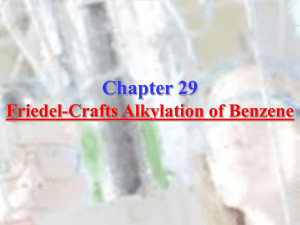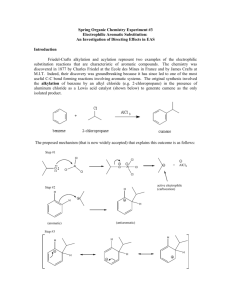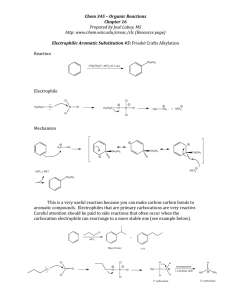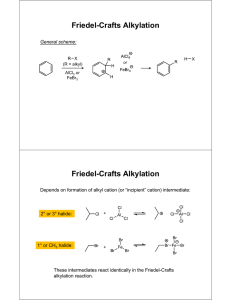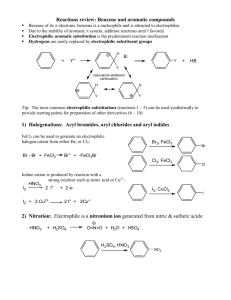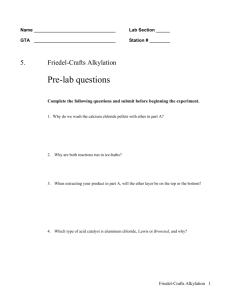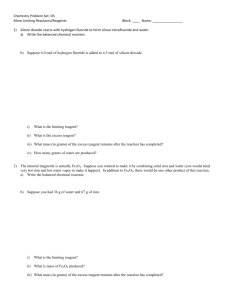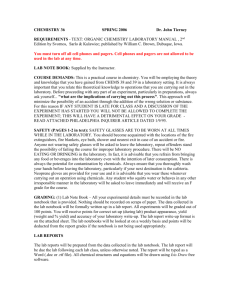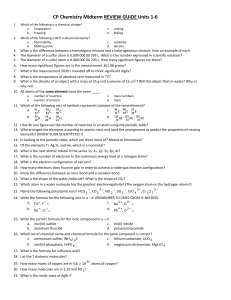Calculating Percent Yield
advertisement
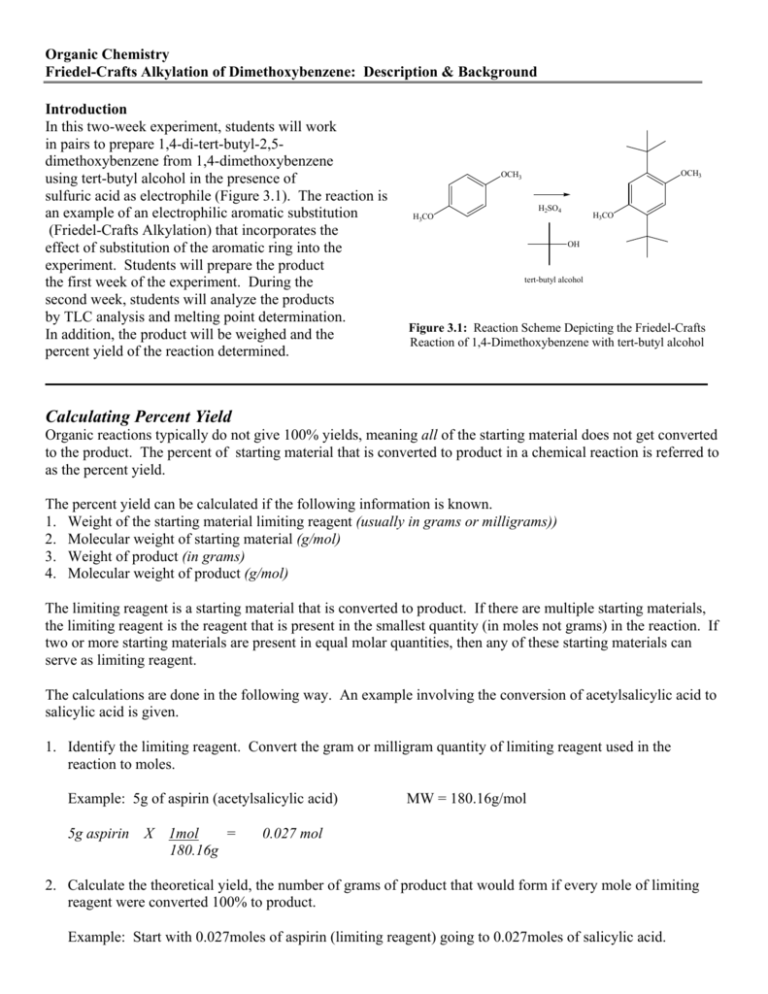
Organic Chemistry Friedel-Crafts Alkylation of Dimethoxybenzene: Description & Background Introduction In this two-week experiment, students will work in pairs to prepare 1,4-di-tert-butyl-2,5dimethoxybenzene from 1,4-dimethoxybenzene using tert-butyl alcohol in the presence of sulfuric acid as electrophile (Figure 3.1). The reaction is an example of an electrophilic aromatic substitution (Friedel-Crafts Alkylation) that incorporates the effect of substitution of the aromatic ring into the experiment. Students will prepare the product the first week of the experiment. During the second week, students will analyze the products by TLC analysis and melting point determination. In addition, the product will be weighed and the percent yield of the reaction determined. OCH3 OCH3 H2SO4 H3CO H3CO OH tert-butyl alcohol Figure 3.1: Reaction Scheme Depicting the Friedel-Crafts Reaction of 1,4-Dimethoxybenzene with tert-butyl alcohol Calculating Percent Yield Organic reactions typically do not give 100% yields, meaning all of the starting material does not get converted to the product. The percent of starting material that is converted to product in a chemical reaction is referred to as the percent yield. The percent yield can be calculated if the following information is known. 1. Weight of the starting material limiting reagent (usually in grams or milligrams)) 2. Molecular weight of starting material (g/mol) 3. Weight of product (in grams) 4. Molecular weight of product (g/mol) The limiting reagent is a starting material that is converted to product. If there are multiple starting materials, the limiting reagent is the reagent that is present in the smallest quantity (in moles not grams) in the reaction. If two or more starting materials are present in equal molar quantities, then any of these starting materials can serve as limiting reagent. The calculations are done in the following way. An example involving the conversion of acetylsalicylic acid to salicylic acid is given. 1. Identify the limiting reagent. Convert the gram or milligram quantity of limiting reagent used in the reaction to moles. Example: 5g of aspirin (acetylsalicylic acid) = 5g aspirin X 1mol 180.16g MW = 180.16g/mol 0.027 mol 2. Calculate the theoretical yield, the number of grams of product that would form if every mole of limiting reagent were converted 100% to product. Example: Start with 0.027moles of aspirin (limiting reagent) going to 0.027moles of salicylic acid. Organic Chemistry Friedel-Crafts Alkylation of Dimethoxybenzene: Description & Background 0.027 mol salicylic acid X 138.12 g mol = 3.72g 3. Divide the number of grams of product obtained experimentally, by the number of grams obtained in the theoretical yield calculations and multiply by 100 to calculate the percent yield. Example: Assume 2.96g of salicylic acid was obtained experimentally. 2.96 3.72 X 100 = 79.5% The Friedel-Crafts Alkylation Reaction The Friedel-Crafts alkylation reaction is one of five types of electrophilic aromatic substitution (EAS) reactions. All five specific types of EAS follow the same reaction mechanism. The general mechanism is as follows: The electrophile must be sufficiently strong to lure pi electrons of aromatic ring to react. The displacement of these electrons results in a high energy T.S. and thus this is the rate determining step of the reaction. The aromatic ring is restored in the second step of the reaction so the reaction is favored overall thermodynamically. H E E+ H (similar to electrophilic addition) A new bond is formed between the electrophile and one of the carbon atoms of the ring, generating a stable carbocation E The electrons from the C-H bond then move down to reform the pi bond and the very stable aromatic ring. (similar to E1) Friedel-Crafts alkylation of benzene and substituted benzenes involves substituting a hydrogen atom on a benzene ring with an alkyl group. Alkylation refers to any reaction in which a new alkyl group is introduced to a molecule. In the Friedel Crafts reaction a new alkyl group becomes bonded to a carbon atom of the aromatic ring. This reaction occurs by treatment of benzene or substituted benzene with a stable carbocation. Organic Chemistry Friedel-Crafts Alkylation of Dimethoxybenzene: Description & Background R R C C R H R R R R δ− δ+ Cl 3 Al X C R R R C R R The carbocation can be generated from various starting materials such as an alkene, alcohols or alkyl halides. The carbocation is the electrophile in this reaction and is generated from an alkyl halide in the reaction shown above. In the reaction that is done in the laboratory, the carbocation is generated from reaction of tert-butyl alcohol with strong acid. Aryl or vinyl halides will not undergo this reaction since these compounds will not generate carbocations. Benzene rings substituted with strong electron-withdrawing groups, such as nitro groups, are not as reactive as benzene, or benzene substituted with electron-donating groups, such as methoxy groups.
